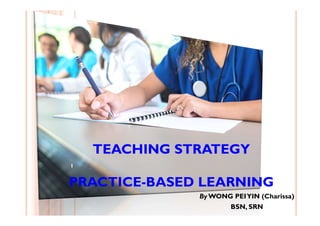
Teaching strategy- practice based learning
- 1. TEACHING STRATEGY PRACTICE-BASED LEARNING By WONG PEIYIN (Charissa) BSN, SRN 1
- 2. LEARNING OUTCOME At the end of the lecture, the student should be able to; Describe practice-based learning. Apply practice-based learning method. Outline an effective practice-based learning method in nursing. Develop the capability to use ideas and information of practical-based learning. Evaluate the advantages and disadvantages of practical-based learning. 2
- 3. INTRODUCTION Teaching strategies includes case studies, demonstration, lectures, group work, simulations, problem-solving and discussion. Used to deliver information to students in the classroom and skill labs. Help students master a set of key ideas and skills to develop achievable goals in the future. Engage students to become independent lifetime learners. Attention to skills that are requied for the student’s role.3
- 4. PRACTICE BASED LEARNING Define the specific knowledge, skills, and attitudes required, as well as provide educational practices under supervision. Has a direct bearing on student’s ability to integrate theory to practice. 4
- 5. CLASS ROOM TEACHING VS PRACTICAL TEACHING CLASS ROOM TEACHING PRACTICAL TEACHING • Large group • Theoretical Knowledge • Theoretical framework • Less interaction • Passive students • Small group • Application of knowledge • Practical reasoning • More interaction • Active students 5
- 6. HOW TO LEARN TO PERFORM? I. Do not focus on memorization. II. Reinforce new information with practice application. III.Repeated practice in simulated situations will reinforce learning. 6
- 7. IMPORTANCE OF INTEGRATING PRACTICE-BASED LEARNING Enable students to learn from experience, rather than teaching. Challenge students to critically think, practice skills and integrate new knowledge into practice. To develop cognitive, affective and psychomotor skills. Give effective feedback. 7
- 8. APPROPRIATE SITUATION FOR PRACTICE BASED LEARNING Students must see, hear and do skills. Cut the lecture time. Focus on application of an integrated scientific knowledge base to the practice. 8
- 9. METHOD OF PRACTICE-BASED LEARNING 1. Modelling - teacher provide examples of expert performance looks like in practice. 2. Demonstrate - offer students opportunities to practice the knowledge and skills under supervision. 3. Learning - allow students to practice in coursework over a period of time, sustained and repeated the task entirety. 9
- 10. 4. Coaching and feedback - teachers provide coaching and constructive feedback as students practice. 5. Analyzing and reflecting – a test or exam in their coursework to analysis and reflection their practice and impact on student learning. 10
- 11. EXAMPLE ~ CPR TRAINING ~ 1. Teacher demonstrate effective CPR. Video. Flow chart guideline. 2. Students practices the skills on manikin in individual under supervision by teacher. 3. Divided group. Role plays. Guide students through scenarios in real- life situation. 4. Briefing session. Teacher give feedback and judgement about their performance. 5. Written/oral test and OSCE. 11
- 12. ADVANTAGES Actively involves participants Focused on specific details Adds variety, reality, and specificity immediate feedback first hand experience with materials build skills before real-world application. Develops problem-solving and verbal expression skills 12
- 13. LIMITATION Depends heavily on learner’s imagination and willingness to participate Puts pressure on learner to perform unpredictable in terms of outcomes time- consuming lack focus 13
- 14. KEY TO SUCCESS Establish a safe environment for learner to experiment and make mistakes without sanction. Use realistic situations that relate to learning objectives. Provide clear directions and specific time limits. Observe performance (for multiple groups, rotate through them) Conduct a feedback/debriefing session. 14
- 15. CONCLUSION Learners remember 80% of what is heard, seen and done. Increase their understanding of scientific knowledge and skills through high quality investigation, reflection and discussion. Students Challenges of new skills requirements, rapid technological developments Increasing social and cultural diversity, and the need to provide for more individualised teaching and special learning needs. Teachers 15
- 16. REFERENCES Price, B., (2007).‘Practice-based assessment: strategies for mentors’, Nursing Standard, 21(36), pp.49-56.Available at: http://journals.rcni.com/doi/pdfplus/10.7748/ns2007.05.21.36.49.c4629 Saputra, J.B. and Aziz, M.S.A.,(2003).‘Teaching strategies’, Teacher and education development. Available at: http://www2.tulane.edu/som/ome/upload/ComparisonOfTeachingMeth odologies.pdf McKimm, J. and Jollie, C., (2007).‘Facilitating learning: teaching and learning methods’, the Deanery’s new web-based learning package for clinical teachers.Available at: http://www.faculty.londondeanery.ac.uk/e-learning/small-group- teaching/Facilitating_learning_teaching_-_learning_methods.pdf Benedict,A., Holdheide, L., Brownell, M. and Foley,A.M., (2016). ‘Learning toTeach: Practice-Based Preparation in Teacher Education’, Center on GreatTeachers and Leaders. Available at: http://ceedar.education.ufl.edu/wp- content/uploads/2016/07/Learning_To_Teach.pdf 16
- 17. THANK YOU 17